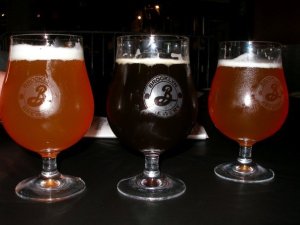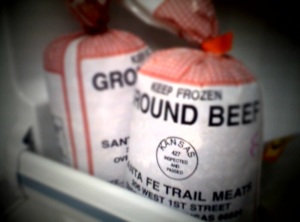The following blog post appears on my “Media and the Environment” class blog and on the Localvores blog on the WellCommons site. I’ve posted it on my blog to share some of what I’ve learned this semester.
I’ve always wanted to have a green beer on St. Patrick’s Day, and with this being my first Patty’s Day as a 21-year-old, I’ve been getting excited to enjoy one.
I guess I get a small thrill from drinking an unnatural-colored beverage for the wow factor. But the concept of green-colored beer got me wondering about the other type of green beer — beer brewed in a sustainable way. Green, or sustainable, beer can include anything from organic beer to beer brewed in breweries that use solar energy or use waste to help fuel the process.

When I went to Brooklyn Brewery this summer, I didn't even know it was a top green brewery in the U.S. (Huffington Post). I had a local beer with New York honey and orange peel.
I’ve heard my parents or my friends say they like local beers more than generic beers, and I agree. Until recently, I had been under the impression that it was a matter of taste. I’ve tried both beers from local breweries (Ad Astra Ale from Free State Brewery being my favorite) and beer, such as Budweiser, Miller, etc., and I definitely notice a difference in quality.
But drinking local means so much more than just quality or taste. Because beer is made from ingredients that are grown outside of where it’s brewed, local breweries are likely to get most of beer’s necessary ingredients from local areas. Of course, this means less emissions because less travel goes into getting those ingredients to a brewery.
I spoke with executive chef at Free State Brewery Rick Martin about the beer at Free State Brewery. He said although the beer at Free State isn’t organic it’s still a natural product because of its ingredients.
Martin also said their beer is almost a zero-waste product because leftover grain from the brewing process at Free State Brewery is sent to local farms to serve as feed for animals.
Until now, I just thought there were local beers and generic beers. Maybe it’s because I’m relatively new to the drinking scene, but I didn’t even consider that there would be such a thing as organic beer. I’m always quick to assume that the word “organic” always applies to food when it really can be applied to items from clothing to beauty products.
Like any other organic item, organic beer’s ingredients are grown without the use of pesticides. Brewing organic beer even produces a clearer beer and a faster fermentation, which I know people like my uncle (who brews his own beer) are always looking for.
There are even green breweries around the U.S. that brew in a sustainable way, using wind energy or recycling waste products.
Thinking about drinking green-colored beer now kind of freaks me out. Most green beer is made by adding food coloring, which is made of food and color additives, to beer.
Not that I’ll now only be drinking organic beer, but I have found ways in which to make smarter beer choices.
— Lauren Cunningham


